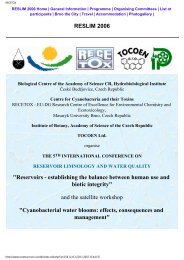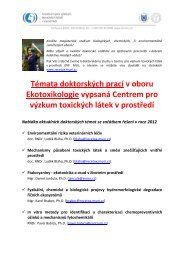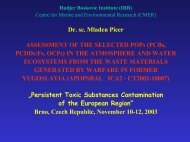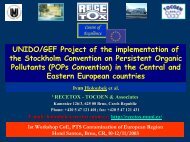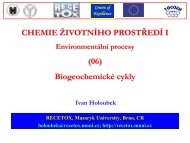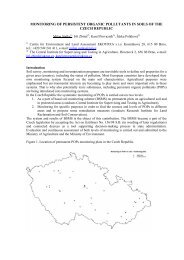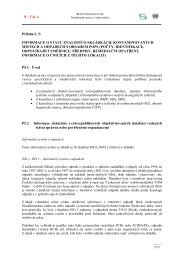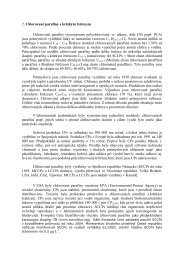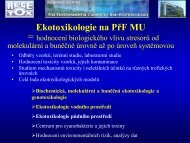Risk for POP mixtures in an Arctic food chain
Risk for POP mixtures in an Arctic food chain
Risk for POP mixtures in an Arctic food chain
You also want an ePaper? Increase the reach of your titles
YUMPU automatically turns print PDFs into web optimized ePapers that Google loves.
<strong>Risk</strong> <strong>for</strong> <strong>POP</strong> <strong>mixtures</strong><br />
<strong>in</strong> <strong>an</strong> <strong>Arctic</strong> <strong>food</strong> cha<strong>in</strong><br />
Marco Vighi<br />
Sara Villa<br />
Department of Environmental Sciences<br />
University of Mil<strong>an</strong>o Bicocca<br />
Italy
2011, the year of <strong>mixtures</strong><br />
�WHO Meet<strong>in</strong>g on comb<strong>in</strong>ed toxicity. London<br />
February 2011<br />
�SETAC Workshop on <strong>mixtures</strong>. Brussels March 2011<br />
�ECETOC Workshop on <strong>mixtures</strong>. Berl<strong>in</strong> July 2011<br />
�Europe<strong>an</strong> Commission, DG SANCO (SCHER, SCCP<br />
SCENIHR) Work<strong>in</strong>g Group on mixture toxicity. An<br />
Op<strong>in</strong>ion is under development to support<br />
Europe<strong>an</strong> regulation. The deadl<strong>in</strong>e is June 2011.<br />
�UNEP-<strong>POP</strong>RC. Case studies to be developed on<br />
<strong>mixtures</strong> of <strong>POP</strong>s
The case study<br />
<strong>POP</strong> <strong>mixtures</strong> <strong>in</strong> the <strong>Arctic</strong><br />
In the frame of the activities of the Stockholm<br />
Convention's Persistent Org<strong>an</strong>ic Pollut<strong>an</strong>ts Review<br />
Committee (<strong>POP</strong>RC) a case study has been developed<br />
<strong>in</strong> order to <strong>an</strong>swer to the follow<strong>in</strong>g questions:<br />
�May the composition of <strong>mixtures</strong> of Persistent<br />
Org<strong>an</strong>ic Pollut<strong>an</strong>ts be determ<strong>in</strong>ed <strong>an</strong>d qu<strong>an</strong>tified <strong>in</strong><br />
remote areas?<br />
�May the ecotoxicological response to <strong>POP</strong> <strong>mixtures</strong><br />
be predicted?<br />
�Is the risk from <strong>POP</strong> <strong>mixtures</strong> matter of concern <strong>for</strong><br />
the <strong>Arctic</strong> ecosystem?
Approaches <strong>for</strong> predict<strong>in</strong>g mixture<br />
response<br />
No <strong>in</strong>teractions among chemicals<br />
�The Dose/Concentration Addition (CA) approach. It applies<br />
to chemicals with the same mode of action.<br />
�The Independent Action (IA) or Effect Addition approach. It<br />
applies to chemicals with different mode of action<br />
Interactions among chemicals<br />
�Synergism <strong>an</strong>d <strong>an</strong>tagonism. They c<strong>an</strong>not be predicted. They<br />
are relatively <strong>in</strong>frequent, particularly at low exposure<br />
levels.
CA as <strong>an</strong> acceptable default approach<br />
A precise knowledge of modes of action is rarely available.<br />
The complexity of toxicological modes of action of <strong>POP</strong>s makes the<br />
problem even more difficult.<br />
The CA approach overestimates the toxicological response, so it<br />
may be assumed as a conservative worst case.<br />
It may be thoeretically demonstrated <strong>an</strong>d experimentally supported<br />
that the ratio CA/IA is generally relatively low.<br />
There<strong>for</strong>e, if the available <strong>in</strong><strong>for</strong>mation is not sufficent <strong>for</strong> a<br />
scientifically based selection between the CA <strong>an</strong>d IA<br />
models, there is large consensus on accept<strong>in</strong>g by default<br />
the CA approach as a realistically acceptable conservative<br />
approach
The dirty dozen<br />
Chlor<strong>in</strong>ated <strong>in</strong>secticides<br />
1. Aldr<strong>in</strong><br />
2. Chlord<strong>an</strong>e<br />
3. Dieldr<strong>in</strong><br />
4. DDT<br />
5. Endr<strong>in</strong><br />
6. Heptachlor<br />
7. Mirex<br />
8. Toxaphene<br />
9. HCB<br />
10.PCDDs (75 congeners)<br />
11.PCDFs (135 congeners)<br />
12.PCBs (209 congeners)<br />
The chemicals<br />
Other chlor<strong>in</strong>ated <strong>an</strong>d<br />
brom<strong>in</strong>ated compounds<br />
13. HCHs<br />
14. PCP<br />
15. PCNs (75 congeners)<br />
16. PBDEs (209 congeners)<br />
Perfluor<strong>in</strong>ated<br />
compounds<br />
17. PFOS<br />
18. PFOA
The exposure<br />
hypothesys<br />
It may be hypothesized that <strong>in</strong><br />
remote areas (e.g. <strong>Arctic</strong>,<br />
Antartica) far from emission sites,<br />
<strong>POP</strong> exposure depends exclusively<br />
upon long r<strong>an</strong>ge atmospheric<br />
tr<strong>an</strong>sport.<br />
There<strong>for</strong>e, <strong>POP</strong> concentrations <strong>in</strong><br />
diferent sites with<strong>in</strong> the <strong>Arctic</strong><br />
Circle should be relatively<br />
homogeneous.<br />
The hypothesis has been checked<br />
<strong>an</strong>d confirmed by compar<strong>in</strong>g, when<br />
available, monitor<strong>in</strong>g data, <strong>in</strong> the<br />
same matrix <strong>an</strong>d <strong>in</strong> comparable<br />
time w<strong>in</strong>dow, from different<br />
sampl<strong>in</strong>g sites.<br />
Ma<strong>in</strong> sampl<strong>in</strong>g areas are <strong>in</strong>dicated <strong>in</strong> the<br />
figure by a red dot
The <strong>Arctic</strong> <strong>food</strong> cha<strong>in</strong><br />
Data on <strong>POP</strong> concentrations <strong>in</strong> different levels of the <strong>Arctic</strong> <strong>food</strong> cha<strong>in</strong>,<br />
sampled <strong>in</strong> the decade 1996-2006, were collected <strong>in</strong> the literature.<br />
Polar Bear<br />
R<strong>in</strong>ged Seal<br />
(adults <strong>an</strong>d babies)<br />
Polar Cod<br />
Zoopl<strong>an</strong>kton<br />
Sea water<br />
Zoopl<strong>an</strong>kton data are relatively scattered<br />
Dietary toxicity data <strong>for</strong> fish are scarce<br />
The follow<strong>in</strong>g risks have been calculated:<br />
�Fish exposed trough water<br />
�Seal eat<strong>in</strong>g fish<br />
�Bear eat<strong>in</strong>g seal<br />
�Baby bear eat<strong>in</strong>g milk
F<strong>in</strong>gerpr<strong>in</strong>t of the composition of the <strong>POP</strong> mixture <strong>in</strong> water <strong>an</strong>d<br />
<strong>in</strong> the org<strong>an</strong>isms of the <strong>Arctic</strong> <strong>food</strong> cha<strong>in</strong><br />
Concentration <strong>in</strong> water pg/L<br />
Concentration <strong>in</strong> biota ng/g lw<br />
10000<br />
1000<br />
100<br />
10<br />
1<br />
0.1<br />
0.01<br />
0.001<br />
Aldr<strong>in</strong><br />
CHL<br />
DDTs<br />
Dieldr<strong>in</strong><br />
Endosulf<strong>an</strong><br />
Endr<strong>in</strong><br />
HBCD<br />
HCB<br />
HCHs<br />
Heptachlor<br />
Heptachlor-hepoxide<br />
Mirex<br />
PBDE<br />
PCB<br />
PCDD<br />
PCDF<br />
PCN<br />
PCP<br />
PFOA<br />
PFOS<br />
Toxaphene<br />
Seawater Zoopl<strong>an</strong>cton Polar Cod R<strong>in</strong>ged seal Polar Bear
The toxicological endpo<strong>in</strong>ts<br />
For mammals several short <strong>an</strong>d long term endpo<strong>in</strong>ts were<br />
available.<br />
However, the comparability of methods <strong>an</strong>d endpo<strong>in</strong>ts was<br />
very difficult.<br />
In absence of suitable data on the same relev<strong>an</strong>t end po<strong>in</strong>t<br />
<strong>for</strong> all chemicals, it was decided us<strong>in</strong>g the Hazard Index (HI)<br />
approach <strong>in</strong>stead of TU.<br />
Hazard Quotients (HQs) <strong>for</strong> <strong>in</strong>dividual chemicals were<br />
calculated us<strong>in</strong>g as Reference Values (RVs) the ADI<br />
(Admissible Daily Intake) proposed <strong>for</strong> protect<strong>in</strong>g hum<strong>an</strong><br />
heath by <strong>in</strong>ternational org<strong>an</strong>isations (WHO, FAO, US EPA).<br />
For fish, only the short term (96h) LC50 was available<br />
<strong>for</strong> all the chemicals.<br />
So, risk was calculated us<strong>in</strong>g the TUs approach<br />
applied to acute LC50.
TUs<br />
0.001<br />
0.0001<br />
1E-05<br />
1E-06<br />
1E-07<br />
1E-08<br />
1E-09<br />
1E-10<br />
1E-11<br />
<strong>Risk</strong> <strong>for</strong> fish trough water<br />
TUs of the total mixture are about four orders of magnitude<br />
lower th<strong>an</strong> the acute toxicity level.<br />
<strong>Risk</strong> <strong>for</strong> fish may be assumed as negligible<br />
Fish<br />
Aldr<strong>in</strong><br />
Chlord<strong>an</strong>es<br />
DDTs<br />
Dieldr<strong>in</strong><br />
Endosulf<strong>an</strong><br />
Endr<strong>in</strong><br />
HBCD<br />
HCB<br />
HCHs<br />
Heptachlor<br />
Heptachlor-hepoxide<br />
Mirex<br />
PBDE<br />
PCB<br />
PCDD<br />
PCDF<br />
PCN<br />
PCP<br />
PFOS<br />
Toxaphene<br />
Total Tus
HQ<br />
10<br />
1<br />
0.1<br />
0.01<br />
0.001<br />
0.0001<br />
0.00001<br />
<strong>Risk</strong> <strong>for</strong> seals eat<strong>in</strong>g fish<br />
The HI of the total mixture is about ten times higher th<strong>an</strong> the<br />
treshold of 1. Consider<strong>in</strong>g that HQs are based on the very<br />
conservative ADI, the risk <strong>for</strong> seals is likely to be very low.<br />
Seal<br />
Aldr<strong>in</strong><br />
Chlord<strong>an</strong>es<br />
DDTs<br />
Dieldr<strong>in</strong><br />
Endosulf<strong>an</strong><br />
Endr<strong>in</strong><br />
HBCD<br />
HCB<br />
HCHs<br />
Heptachlor<br />
Heptachlor-hepoxide<br />
Mirex<br />
PBDE<br />
PCB<br />
PCDD<br />
PCDF<br />
PCN<br />
PCP<br />
PFOS<br />
Toxaphene<br />
HI
HQ<br />
1000<br />
100<br />
10<br />
1<br />
0.1<br />
0.01<br />
0.001<br />
<strong>Risk</strong> <strong>for</strong> bears eat<strong>in</strong>g seals<br />
The HI of the total mixture is two orders of magnitude higher<br />
th<strong>an</strong> the treshold of 1.<br />
The risk <strong>for</strong> bears is likely to be signific<strong>an</strong>t.<br />
Adult Bear<br />
Aldr<strong>in</strong><br />
Chlord<strong>an</strong>es<br />
DDTs<br />
Dieldr<strong>in</strong><br />
Endosulf<strong>an</strong><br />
Endr<strong>in</strong><br />
HBCD<br />
HCB<br />
HCHs<br />
Heptachlor<br />
Heptachlor-hepox.<br />
Mirex<br />
PBDE<br />
PCB<br />
PCDD<br />
PCDF<br />
PCN<br />
PCP<br />
PFOS<br />
Toxaphene<br />
HI
HQ<br />
10000<br />
1000<br />
<strong>Risk</strong> <strong>for</strong> baby bears eat<strong>in</strong>g milk<br />
The HI of the total mixture is three orders of magnitude<br />
higher th<strong>an</strong> the treshold of 1.<br />
The risk <strong>for</strong> baby bears is likely to be very high.<br />
100<br />
10<br />
1<br />
0.1<br />
0.01<br />
Aldr<strong>in</strong><br />
Chlord<strong>an</strong>es<br />
DDTs<br />
Dieldr<strong>in</strong><br />
Endosulf<strong>an</strong><br />
Baby Bear<br />
Endr<strong>in</strong><br />
HBCD<br />
HCB<br />
HCHs<br />
Heptachlor<br />
Heptachlor-hepox.<br />
Mirex<br />
PBDE<br />
PCB<br />
PCDD<br />
PCDF<br />
PCN<br />
PCP<br />
PFOS<br />
Toxaphene<br />
HI
Value <strong>an</strong>d limitations of the sìtudy <strong>an</strong>d needs <strong>for</strong><br />
improvement<br />
The Case Study represents a first tier assessment based<br />
on m<strong>an</strong>y default worst-case assumptions.<br />
It needs to be ref<strong>in</strong>ed. However, the risk <strong>for</strong> the highest<br />
levels of the trophic cha<strong>in</strong> is likely to occur.<br />
Endocr<strong>in</strong>e disorders <strong>in</strong> baby polar bears is documented <strong>in</strong><br />
the literature (Vos et al., 2000; Wiig et al., 1998).<br />
The next step will be a comparison between these<br />
relatively recent data <strong>an</strong>d older ones (start<strong>in</strong>g from 1970s)<br />
<strong>in</strong> order to reconstruct<strong>in</strong>g the time course of the last four<br />
decades <strong>an</strong>d to check the effectiveness of control<br />
measures .
Acknowledgements<br />
The work has been per<strong>for</strong>med <strong>an</strong>d supported <strong>in</strong> the<br />
frame of the activities of the Stockholm Convention's<br />
Persistent Org<strong>an</strong>ic Pollut<strong>an</strong>ts Review Committee<br />
(<strong>POP</strong>RC).<br />
UNEP/<strong>POP</strong>S/<strong>POP</strong>RC



